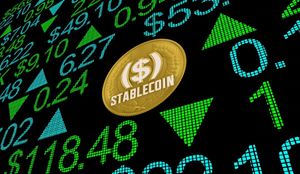Market Roars as Investors Bet Big on Imminent Fed Rate Cuts

Major U.S. stock indexes experienced a significant surge at the start of a holiday-shortened week, with the Dow Jones, Nasdaq, and S&P 500 all posting robust gains. This powerful rally was primarily fueled by growing investor confidence that the Federal Reserve is poised to implement interest rate cuts in the near future, signaling a potential easing of monetary policy. The optimistic sentiment marks a notable rebound for the markets, which had faced a challenging period of volatility.
The immediate implications of this market uplift are a renewed sense of optimism among investors, particularly concerning growth-oriented sectors like technology. As borrowing costs are expected to decrease, companies could see improved profitability and a boost in consumer spending, creating a favorable environment for equities. However, with the Thanksgiving holiday leading to thinner trading volumes, analysts caution that volatility could remain a factor in the coming days.
Fed Dovish Signals Ignite Broad Market Rally
The catalyst for Monday's impressive market performance on November 24, 2025, was a series of dovish remarks from key Federal Reserve officials that dramatically shifted investor expectations regarding monetary policy. New York Federal Reserve President John Williams had indicated on the preceding Friday, November 21st, that there was "room for a further adjustment" in the central bank's interest rates "in the near term." This statement alone propelled the probability of a 25-basis-point rate cut in December from less than 40% to over 70%, with some market tools even pegging it at 77%. Further solidifying this sentiment, Federal Reserve Governor Christopher Waller publicly advocated for a December rate cut, noting that economic data had shown little change since the last Fed meeting.
These pronouncements sparked a broad market rally, extending gains seen on the previous Friday. The tech-heavy Nasdaq Composite (NASDAQ: IXIC) led the charge, surging by an impressive 2.6%, or 369.97 points, to close at 22,643.06. This was driven by a strong rotation back into riskier assets, with AI-linked stocks performing exceptionally well; Alphabet (NASDAQ: GOOGL) rose approximately 6% following the unveiling of Gemini 3, and Tesla (NASDAQ: TSLA) jumped 7% after Elon Musk's comments on chip production. The benchmark S&P 500 (NYSEARCA: SPY) climbed 1.6%, or 65.78 points, to 6,668.77, with nearly 90% of its constituent stocks advancing. The blue-chip Dow Jones Industrial Average (NYSEARCA: DIA) also posted solid gains, rising 0.6%, or 119.52 points, to 46,364.93.
It's important to contextualize these gains against the backdrop of the preceding week, which had been marked by disappointment and declines. Concerns over AI spending and the high valuations of big technology firms had led the Nasdaq to drop 2.7%, while both the Dow and S&P 500 fell 1.9%. The current surge represents a significant rebound from this recent weakness, highlighting the market's sensitivity to shifts in monetary policy expectations. As the holiday shopping season commences, investors are now keenly watching consumer spending data for further economic cues, alongside the evolving narrative from the Federal Reserve.
Rate Cuts: A Game Changer for Corporate Fortunes
The prospect of impending Federal Reserve interest rate cuts is poised to significantly reconfigure the landscape for public companies, creating distinct winners and losers across various sectors. As borrowing costs decrease and economic activity is stimulated, the market anticipates a substantial shift, particularly if these cuts occur outside of a recessionary environment, a scenario that generally bodes well for equity markets.
Technology and Growth Stocks Set to Soar: The most immediate beneficiaries are expected to be growth stocks and technology companies. These firms, which frequently rely on external funding for aggressive expansion, research, and development, will find cheaper borrowing costs a significant boon. Lower interest rates enhance the present value of their future earnings, driving up valuations, especially for companies in their high-growth phases that may not yet be consistently profitable. This environment also typically fosters easier access to capital, potentially leading to more initial public offerings (IPOs) and increased mergers and acquisitions (M&A) activity within the tech sector. Artificial intelligence (AI) stocks, in particular, are highlighted as major beneficiaries, with giants like Microsoft (NASDAQ: MSFT) and Alphabet (NASDAQ: GOOGL) positioned to capitalize on enhanced investment opportunities.
Real Estate, Utilities, and Consumer Discretionary to See Boosts: The real estate and housing sectors are also poised for a significant uplift. Lower interest rates directly translate to more affordable mortgage payments, stimulating buyer demand, increasing transaction volumes, and potentially leading to higher property values. Homebuilders such as D.R. Horton (NYSE: DHI) and Lennar (NYSE: LEN), alongside Real Estate Investment Trusts (REITs) like Prologis (NYSE: PLD), are expected to experience increased sales and property values. Utilities, being capital-intensive and often carrying substantial debt, will see their financing costs reduced, improving profit margins. These defensive stocks, often considered "bond proxies," become more appealing to income-seeking investors as bond yields decline. Companies like NRG Energy (NYSE: NRG) and NextEra Energy (NYSE: NEE) are well-positioned. Furthermore, consumer discretionary stocks stand to benefit as lower rates boost disposable income by reducing debt servicing costs, encouraging increased spending on non-essential goods and services, which could favor companies like Crocs (NASDAQ: CROX) and Royal Caribbean Cruises (NYSE: RCL).
Mixed Bag for Financials, Headwinds for Savers: The financial sector, particularly banks, faces a more nuanced outlook. While lower borrowing costs can stimulate loan demand and consumer spending, potentially boosting lending activity, falling interest rates typically compress net interest margins (NIMs)—the difference between what banks earn on loans and pay on deposits. This can challenge profitability. However, increased loan volumes and higher fee-based services could partially offset margin compression. Investment banks like Goldman Sachs (NYSE: GS) could see a boost from stimulated capital markets activity. Conversely, savers and fixed-income investors are generally on the losing end, as banks reduce interest paid on savings accounts, CDs, and money market accounts, and newly issued bonds offer lower yields. Small-cap stocks (NYSEARCA: IWM) generally tend to outperform during rate-cut periods outside of recessions, as they often have more floating-rate debt and are more leveraged to domestic growth.
A Sea Change in Economic Tides: Broader Implications of Fed's Dovish Pivot
The market's enthusiastic response to anticipated Federal Reserve interest rate cuts signals a potentially profound shift in the economic landscape, with wide-ranging implications for industries, competitive dynamics, regulatory frameworks, and global financial stability. This expected easing cycle, currently anticipated to begin as early as December 10, 2025, with a strong probability of a 25-basis-point reduction, echoes historical patterns of monetary policy adjustments designed to stimulate growth.
Reshaping Industry Dynamics and Economic Growth: A reduction in borrowing costs, the primary objective of rate cuts, is designed to fuel economic expansion. Businesses will find it cheaper to finance operations, undertake acquisitions, and launch new projects, thereby encouraging capital expenditure, potentially boosting corporate earnings, and stimulating job growth. Consumers, in turn, benefit from lower interest rates on mortgages, auto loans, and credit cards, increasing their disposable income and incentivizing spending on big-ticket items. This dynamic is particularly beneficial for the real estate sector, with single-family homebuilders expected to see a significant surge in demand. Investor preferences also shift; as yields on fixed-income assets like bonds decline, capital often flows into equities in search of higher returns, further propelling stock prices. While this generally positive outlook prevails, it's crucial to acknowledge potential downsides, such as reduced yields for long-term savers and the risk of fostering inflationary pressures if economic growth outpaces supply.
Competitive Landscape and Innovation: The ripple effects on competitors and partners are equally significant. Financially agile firms or those capable of quickly refinancing existing debt at lower rates will gain a competitive advantage, freeing up capital for investment, innovation, or market expansion. Cheaper borrowing costs are also a potent driver for increased mergers and acquisitions (M&A) activity, potentially leading to industry consolidation. Small-to-medium-sized IT companies, in particular, may find it easier to pursue new projects, launch products, and upgrade technology, fostering innovation and market growth. However, a prolonged period of very low interest rates can paradoxically dampen competition by allowing dominant firms to invest more aggressively and widen the productivity gap, potentially discouraging smaller rivals and leading to increased monopolization within industries.
Regulatory Vigilance and Global Repercussions: From a regulatory and policy standpoint, a period of anticipated Fed rate cuts necessitates heightened vigilance. Financial regulators will likely intensify their monitoring for potential asset bubbles, especially in real estate and equity markets, as cheap money can encourage increased risk-taking. Scrutiny of lending standards may also increase if banks, eager to boost loan volumes, become less stringent in their credit assessments. Globally, a dovish Fed could provide cover for other central banks, such as the European Central Bank (ECB) and the Bank of Japan, to pursue their own easing cycles, potentially leading to a synchronized global effort to stimulate economic activity. Conversely, policy divergence could impact currency markets, with Fed rate cuts typically weakening the U.S. dollar, which can benefit emerging market economies by reducing their dollar-denominated debt burdens and making their exports more competitive.
Historical Context: A Mixed but Often Positive Precedent: Historically, the S&P 500 (NYSEARCA: SPY) has generally performed well during rate-cutting cycles. Since 1974, the index has gained an average of 30.3% from the first cut until the next hiking cycle, finishing higher in six out of nine such cases. Notable bull markets, such as the 161% surge from 1995 to 1999 or the 38.2% rise from 2019 to 2021, followed periods of falling interest rates. The crucial distinction lies in the context of the cuts: those made to address "soft patches" or as a preventive measure before a full-blown recession, as appears to be the case currently, tend to inject new growth momentum into the market. This contrasts with crisis-driven cuts, like those during the 2007-2009 financial crisis, which initially did not prevent market drops but ultimately helped fuel strong recoveries. The market's current optimism suggests it views the Fed's potential move as a preventive measure, aimed at sustaining growth rather than reacting to a deepening crisis.
The Road Ahead: Navigating the Post-Rate Cut Landscape
The robust surge across major U.S. stock indexes at the onset of this holiday-shortened week marks a significant moment, driven by a palpable increase in investor confidence regarding imminent Federal Reserve interest rate cuts. This "risk-on" sentiment, fueled by dovish signals from key Fed officials, has injected a renewed sense of optimism into the markets, particularly benefiting growth-oriented sectors and setting a potentially new course for the economy.
Short-Term Outlook: Volatility Amidst Optimism (Late 2025 - Mid-2026): In the immediate future, financial markets will remain highly sensitive to incoming economic data and further communications from the Federal Reserve. Equities, particularly U.S. large caps (NYSEARCA: SPY) and rate-sensitive sectors like technology, small caps (NYSEARCA: IWM), and real estate, are generally expected to perform well in a non-recessionary rate-cutting environment. Bond markets could see continued interest, with a recommendation to shift out of cash into targeted bonds, especially in the short-to-intermediate credit space, as cash yields are projected to fall. Economically, consumer spending is anticipated to remain relatively strong through the end of 2025 before a more substantial slowdown in 2026. GDP growth is projected to moderate in 2025 before accelerating in 2026. Inflation remains a critical watchpoint, with core CPI still above the Fed's 2% target, while the labor market shows mixed signals of softening. Analysts like J.P. Morgan Research and ING anticipate further rate cuts into 2026, aiming to prevent labor market weakening and support economic growth.
Long-Term Trajectory: Gradual Normalization (2026-2028): Looking further out, the trajectory of rate cuts and their economic impact will continue to shape the market. Morningstar projects a total of 2 percentage points in cuts through the end of 2027, bringing the federal funds rate to a target range of 2.25%-2.50%. Deloitte anticipates a steady decrease to 3.125% by the fourth quarter of 2026. This gradual easing is expected to support a normalization of inflation towards the Fed's 2% target by 2027-2028, assuming a benign economic outlook. The 10-year Treasury yield is also anticipated to trend downward, potentially averaging 3.25% by 2028, a historical tailwind for stock performance when cuts are gradual and not recession-driven.
Strategic Pivots for Investors and Corporations: Both investors and corporations will need to adapt their strategies. For investors, reallocating from cash into targeted bonds (favoring short-to-intermediate credit) and maintaining diversified equity exposure, particularly in quality U.S. large caps and rate-sensitive sectors, will be key. Building bond ladders with ETFs can help lock in current yields. Corporations should prioritize flexible strategic planning, including scenario analysis, to navigate economic changes. Continued investment in IT, software services, AI, and data analytics will be crucial for efficiency and growth. Lower borrowing costs also present opportunities for refinancing existing debt or taking on new debt for expansion and innovation.
Opportunities and Challenges on the Horizon: A "soft landing" scenario, with gradual rate cuts, presents significant opportunities for continued positive returns across most asset classes, led by growth stocks and high-yield bonds. Commercial real estate is expected to see a boost in investment volume, and a U.S. rate-cutting cycle could support global risk assets. Strong household wealth gains in 2025 also provide a tailwind for consumer spending. However, challenges loom. Persistent inflation, potentially exacerbated by tariffs, could force the Fed to pause or reverse cuts, negatively impacting long-dated bonds. High valuations, especially in AI-linked stocks, could lead to renewed selling pressure if earnings disappoint. Diverging expectations between the market and the Fed could also trigger volatility, and any significant labor market weakness could signal deeper economic issues.
Potential Scenarios and Outcomes: The future hinges on several potential scenarios:
- "Soft Landing" (Baseline): The Fed successfully guides the economy to moderate growth and cooling inflation without a recession, leading to sustained equity gains.
- "Stagflationary Drift" (Risk): Inflation remains sticky alongside slowing growth, challenging the Fed's mandate and creating a volatile market.
- "Hard Landing" / Recession (Downside): Underlying economic weaknesses or external shocks lead to a recession, causing significant corporate earnings declines and market drops.
- "Overheating and Renewed Inflation" (Upside Risk to Inflation): Aggressive rate cuts or overly potent stimulus lead to a resurgence of inflation, forcing the Fed to reverse course and hike rates again, causing market disruption.
The coming months will be defined by the interplay of monetary policy, inflation trends, and labor market resilience. Strategic adaptation and careful monitoring of economic signals will be essential for all market participants.
Conclusion: Navigating the Easing Cycle's Promise and Perils
The robust surge across major U.S. stock indexes at the onset of this holiday-shortened week marks a significant moment, driven by a palpable increase in investor confidence regarding imminent Federal Reserve interest rate cuts. This "risk-on" sentiment, fueled by dovish signals from key Fed officials, has injected a renewed sense of optimism into the markets, particularly benefiting growth-oriented sectors and setting a potentially new course for the economy.
Key Takeaways and Forward Market Assessment: The week's rally, seeing the Nasdaq Composite (NASDAQ: IXIC) surge alongside strong gains for the S&P 500 (NYSEARCA: SPY) and Dow Jones Industrial Average (NYSEARCA: DIA), underscores the profound influence of monetary policy expectations. The anticipated easing cycle, with projections for further cuts into 2026, is widely expected to create a supportive environment for corporate earnings, stimulate investment, and boost consumer spending. Sectors like technology, real estate, consumer discretionary, and small-cap stocks are particularly well-positioned to capitalize on cheaper capital and enhanced demand. However, this optimism is tempered by lingering concerns over elevated valuations, especially within the AI-linked tech sector, and the persistent threat of inflation, which could complicate the Fed's path forward. The current cuts are largely seen as "risk management" to prevent economic slowing rather than a definitive shift to aggressive easing, suggesting a nuanced approach will be required.
Lasting Impact and Strategic Imperatives: The lasting impact of this period hinges on the Federal Reserve's ability to orchestrate a "soft landing"—where inflation cools to target levels without triggering a significant economic downturn. If successful, this could establish a more stable foundation for sustained growth into 2026 and beyond, reshaping investment strategies and encouraging a shift from cash and short-duration assets into longer-term bonds and riskier equities. Conversely, a misstep could lead to renewed volatility, challenging the market's current trajectory. For corporations, adaptability, strategic investment in technology, and prudent debt management will be crucial. Investors, meanwhile, should consider reallocating from cash into targeted bonds, maintaining diversified equity exposure with a focus on quality U.S. large caps and rate-sensitive sectors, and exploring alternative income strategies.
What Investors Should Watch For: In the coming months, vigilance will be paramount. Investors must closely monitor:
- Federal Reserve Communication: The precise language and tone from Fed Chair Jerome Powell and other FOMC members will provide critical cues on the future path of monetary policy.
- Key Economic Data: Upcoming inflation reports (PCE, CPI), labor market statistics (jobs reports, unemployment rate), and GDP growth figures will directly influence the Fed's decisions and market sentiment.
- Corporate Earnings: Forthcoming earnings reports, particularly from rate-sensitive sectors and technology companies, will be vital to justify current market valuations.
- Geopolitical Developments and Trade Policies: Global events and shifts in trade policy could introduce unexpected volatility and affect market stability.
The current market surge, while exhilarating, demands a disciplined and informed approach. The interplay between monetary policy, economic data, and corporate performance will define the market's trajectory into 2026, presenting both significant opportunities and considerable challenges.
This content is intended for informational purposes only and is not financial advice
More News
View More




Recent Quotes
View More
Quotes delayed at least 20 minutes.
By accessing this page, you agree to the Privacy Policy and Terms Of Service.